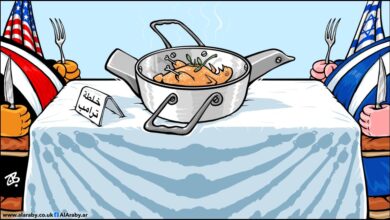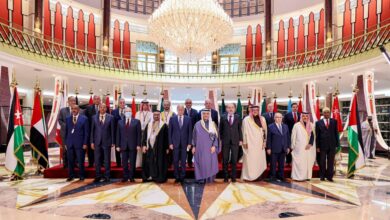
By Paul Rogers, The Guardian.
Just as in Afghanistan and Iraq, using intense force against paramilitaries is not working. Once more it will have disastrous consequences.
At the start of the second month of the Gaza war, two questions emerge: what kind of conflict are we witnessing and how long will it last? These questions force us to consider longer trends in modern warfare, linked not just to the post-9/11 “wars on terror” but to a more global security paradigm that is about maintaining control, rather than addressing the underlying causes of revolt.
In the immediate aftermath of Hamas’s 7 October assault, Benjamin Netanyahu talked of crushing the organisation so that it could never again threaten Israel. It was eerily similar to George W Bush’s declaration against al-Qaida and the Taliban after 9/11, which had dire consequences, especially for Afghanistan and Iraq.
In a similar vein, and after a month of war, Netanyahu’s intention is to destroy Hamas. This will be followed by long-term control of Gaza, not just fencing it off. As Netanyahu put it: “Israel will for an indefinite period have the overall security responsibility, because we have seen what happens when we do not have it.” Given the increasing pressure from West Bank settlers and the rise in violence, a high level of policing and military patrols will be essential there as well.
Even if Hamas can be destroyed in Gaza, which is already looking problematic – if, indeed, it is even possible – the ideas and aspirations behind it will remain, no doubt bolstered by many tens of thousands of younger people experiencing the full impact of this war.
We need to remember the specific and shocking circumstances that brought us to this point. More than 1,400 Israelis and foreign nationals were killed in the violent attacks of 7 October. That was nothing short of catastrophic but was also a terrible loss of control – Israel’s worst civilian loss for 75 years.
This struck at the heart of a state that has perhaps unknowingly lived the paradox of being impregnable in its insecurity. Jews in Israel simply had to feel secure, a need going right back to the experience of the Holocaust and even earlier. They created a very well-armed Israel but one that was opposed by the displaced Palestinians and many millions of people in the surrounding states.
Since 7 October, more than 10,000 Palestinians have already been reported killed in this quest for security, including more than 4,000 children. Large parts of Gaza City have been reduced to rubble, and Israeli control of energy, food and water supplies across the whole Gaza Strip is adding hugely to the suffering.
The Israeli Defence Forces (IDF) is now engaged in the slow process of trying to fight the Hamas paramilitaries on their own territory. It is already taking many casualties, with the IDF’s specialist casualty evacuation group, Unit 669, airlifting about 260 wounded soldiers to Israel in the first few days, well before the main fighting in the dense urban areas fully unfolds.
Recent experience – Russia in Mariupol, western troops in Mosul (2016), Raqqa (2017) and Falluja (2004) – shows that in modern urban warfare the intense use of airpower and bombardment with huge loss of life is all too common. This is now unfolding in Gaza, but, with international criticism rising, time is not on Israel’s side.
How did we get here? Until last month, Israel had ensured its security by heavy use of military and paramilitary forces, persistent control of populations and high levels of surveillance, together with well-resourced intelligence and security agencies. It is a paradigm of control that can be termed “liddism”, keeping the lid on a problem rather than turning down the heat – and it has global significance with potentially disastrous consequences.
Wars in Afghanistan, Iraq, Libya and elsewhere have repeatedly shown the difficulties of using intense force against paramilitaries. Now look at the consequences of those wars, which independent monitoring groups such as Iraq Body Count, Airwars and Brown University’s Costs of War centre have helped make public. So far, these post-9/11 wars have killed more than 900,000 people through direct violence and a further 3.5 million indirectly, with 38 million people displaced.
None has produced, or seems likely to produce, a lasting peace. Conflict continues in Iraq and Syria, including US airstrikes, while Islamic State and al-Qaida-linked militias are active right across the Sahel region and through to Somalia, with other states such as Uganda, Kenya, the DRC and even Mozambique affected.
The war in Gaza is a microcosm of a global reliance on military responses to what are, at root, not military problems but problems that often relate to questions of justice, political representation and economic development. Furthermore, Gaza and the Ukraine war have meant a veritable bonanza for the global arms industry, with military spending going through the roof.
The best realistically possible case for Gaza just now is that Netanyahu will have to eventually agree a ceasefire, and sufficient international pressure will open the possibility of a settlement. Beyond that, there still lies the much greater task of rethinking what is even meant by international security if a perpetually unstable world is to be avoided. Liddism won’t work in Gaza and will not work in the wider world.
Fifty years ago, the economic geographer Edwin Brooks warned of the risk of the world becoming a “crowded glowering plant of massive inequalities of wealth buttressed by stark force yet endlessly threatened by desperate men in the global ghettoes”. That looks decidedly prophetic now. But if an alternative definition of prophecy is “suggesting the possible”, then such an approach is very badly needed now, along with a serious debate about what is meant by “security”.





